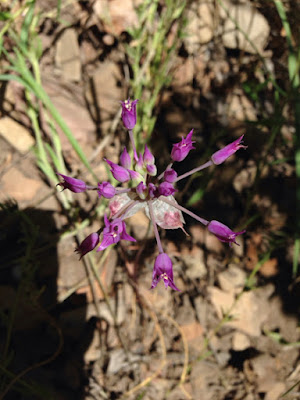 |
| Allium biceptrum |
 |
| Allium acuminatum |
We have several species of wild onions in my area, including Allium acuminatum or Tapertip Onion (whose flowers are a bright purple color, fading to white with age), and Allium bisceptrum or Aspen Onion (whose flowers are pale pink). I have also tried Allium cernuum or Nodding Onion. All the wild onions are similar in taste, and the intensity of the onion flavor can vary from plant to plant within the species. It can also vary by location, because the amount of sulfur in the soil affects the flavor strongly.
Many people worry about confusing wild onions with other similar-looking plants, but I have not found it very easy to be confused, unless you are looking at young specimens before they flower, which is always difficult. The onion smell and taste are always a reliable indicator. Even if you don't want to smell or taste them to be sure, it is not that difficult. The species that are cited the most as worrisome confusors are Camas (Camassia species) and Death Camas (Zigadenus species). But both of these genuses grow their flower clusters in racemes, where the flowers branch one by one from a central stalk, instead of in an umbel, where all the flowers branch from a single point. Allium flowers come in many colors, but always cluster together in an umbel. In addition the young cluster is completely covered by a papery sheath, making the entire cluster look like a single bud. And the cluster grows on top of a "naked scape", or stem without leaves. The long and usually flat leaves rise from the same spot as the scape, from a shallow bulb.
The only thing easily confused with wild onions is Wild Hyacinth, which has bright blue flowers in an umbel, but the flowers are larger and more urn-shaped, with the bottom half of the petals united. Wild Hyacinth is also edible, but does not smell of onions.
The bulbs of wild onions are small (about 1/2 inch), which is normal for wild edibles. But the entire plant is flavorful, and it should all be used, except maybe the rootlets below the bulb. The flower stalk and leaves can be used like scallions or green onions. I have found that the flowers or unopened flower cluster is often the part with the strongest flavor. The mature flowers are also good to eat, and make an attractive and very tasty addition to any salad.
I use a lot of onions in my day-to-day cooking, so it is good you know I can find the same flavor I love in the wild as well. Onions can grow lots of places, but I find them most often in moister areas (or at least, less dry areas), and usually shaded by taller trees. They can be some of the earliest plants to grow in the spring, and are available throughout the summer.
No comments:
Post a Comment